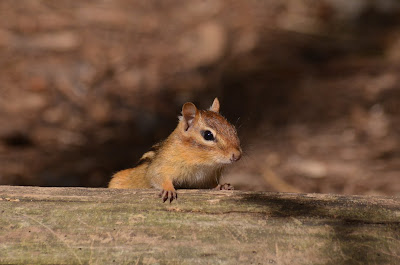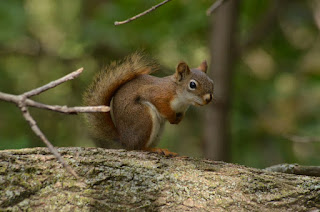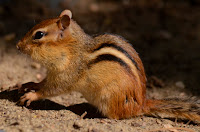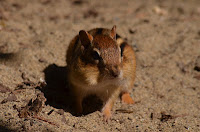 |
| Stripes, the chipmunk |
What: While out in my yard I also got to spend some time with the lone chipmunk (Tamias striatus) in the back, one of the two woodchucks (Marmota monax) that frequents our garden, and the two red squirrels (Tamiasciurus hudsonicus) that battle for dominance over the walnut (Juglans nigra). We’ve got another chipmunk that spends its time in the front yard, but this one has a distinguishing mark on its rear left leg that would make it easy to ID if they ever do cross paths.
The beta red squirrel is a male, but I couldn’t tell about the other one yet. The alpha seems redder, and a bit more run-down, like it’s tired from all the time it spends defending the walnut from intruders. This morning I watched two gray squirrels (Sciurus carolinensis) stalk up to the tree, climb it and stealthily drop a couple of walnuts to the ground. As soon as the walnuts thudded loudly down, the red squirrel jumped to action and furiously chased the grays away. The grays sprinted down, hurriedly grabbed the two walnuts and then gleefully ran off together to cache them safely away. I was surprised to see them work together. I call the alpha the alpha because it’s the one that is king of the hill, or rather king of the walnut.
 |
| Beta red squirrel approaching the alpha’s territory |
 |
| A few seconds later the alpha came over to bark at the beta |
We also have a woodchuck that enjoys eating the chicken food. About a month ago I made a deal with the woodchuck that if it stopped eating our garden I would leave food out back for it. It paused long enough to listen to me then ran off. The next day I was back out in the yard and the woodchuck came running up. It approached me slowly, walked right up to me, nudged me on the leg with its nose, then turned around and trotted back off to where it came from. It seemed like it was accepting the terms of our agreement.
Ecological notes: All of these little critters are technically (or taxonomically) squirrels. That is, they all belong to the family Sciuridae. Squirrels are rodents (Order Rodentia), so they have an upper and lower pair of incisors that are chisel shaped and reinforced with iron, which gives them that yellowish orange tint.
Where: Still my backyard



